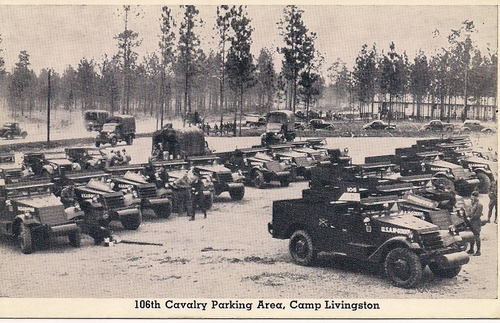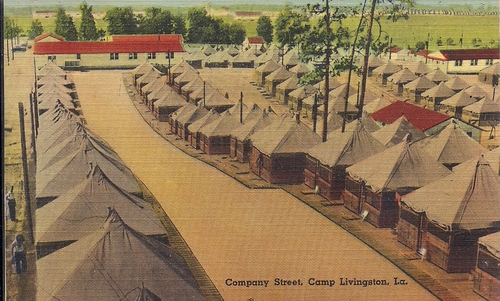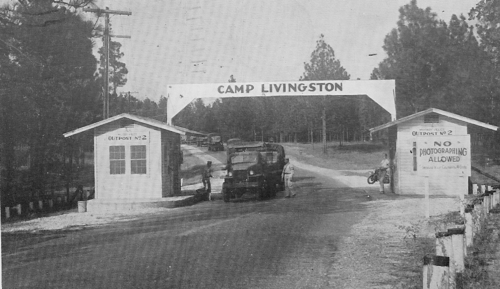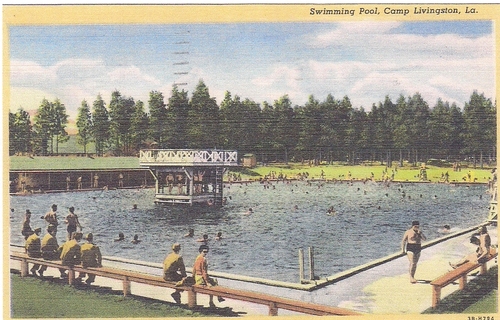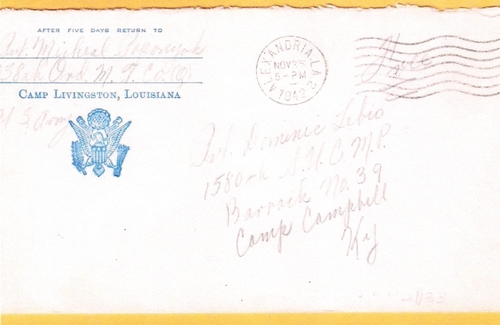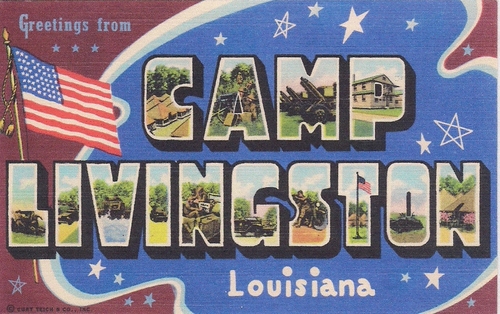.JPG)
By Rickey Robertson
During World War II, Louisiana had many famous military bases located within her boundaries. These bases were the home to many different units, from armor, infantry, cavalry, and artillery units. Last month we visited Camp Beauregard and this month we will visit Camp Livingston. Camp Livingston was located a few miles north of Pineville near the little town of Ball, Louisiana. When the army decided to build the new army camp it was to be known as "Camp Tioga". It was renamed Camp Livingston in honor of Chancellor Robert R. Livingston, who had negotiated the Louisiana Purchase from France in 1803. Camp Livingston, besides being the permanent home of the 32ndDivision, would also become a designated infantry replacement center. The 28th, 32nd,and 86th Infantry Divisions would also at various times during the war call Camp Livingston home. Construction was began on September 16, 1940. A total of 21 million dollars was spent in the building of Camp Livingston. Needing housing for the 32nd Division as soon as possible, the army could not wait on favorable weather conditions, so contractors worked 50 days in the rain and mud laying out the camp and some of its buildings. The post would consist of 35 administrative buildings, 19 sets of officer's quarters, 223 mess halls, 19 recreation buildings, 20 post exchanges, 2 guest houses, 2 service clubs, 2 tent theaters, 234 latrines, 18 infirmaries, 37 repair shops, 4 fire stations, 1 post laundry, a large cold storage plant, 1 bakery, 1 shed for storing hay, 9 stables for horses and mules, 5 ordnance magazines to store ammunition of all types, a dental clinic, 1 post office, 1 telephone and telegraph building, 46 warehouses, 26 service stations with at least 52,000 gallon capacity, and one central gas station with at capacity of 72,000 gallons of gasoline.
To provide water for this large camp, nine gravel walled wells, all over 400 feet deep and equipped with turbine pumps were drilled. These large pumps would transfer and deliver water into three surface reservoirs each with a million gallon capacity. To provide for the treatment of the water, a chemical treatment facility was built. For fire protection for the post, over 340 fire hydrants were connected to the water system, with four fully equipped fire stations stationed strategically throughout the camp. Besides the water facilities the post also had a large and proper sewage an garbage disposal facility. A 10 ton incinerator was erected and over 35 miles of sewer lines were laid, which was in turn linked to the modern sewage plant.
The Camp Livingston Station Hospital when built was capable of housing and taking care of over 1250 patients, and included 1 administrative building, 9 officers and nurses quarters, 4 officers and nurses mess halls, 9 barracks for enlisted personnel, 4 clinics, 1 infirmary, 41 wards, a PX, 6 storehouses for medical supplies,3 recreation buildings, a Dental Clinic, and 1 morgue. There were over 6450 feet of enclosed and covered walkways connecting all the buildings. At the station hospital there was a total of 82 buildings housing all these different sections. Colonel Henry C. Michie was the first commanding officer of the station hospital at Livingston.
While the camp was being constructed and permanent type buildings were under construction, there were 885 officers tents and 6756 enlisted men's tents to house the personnel. Many of the tents that the soldiers lived in were similar to cottages with canvas tops. Each tent had floors and framing for walls and were covered with canvas. These tents were sealed against the weather and had some sort of gas heating and electric lights. Officers tents were occupied by 2 officers and enlisted tents had a capacity of 8 men. Each company had a permanent wooden building housing the mess hall and kitchen, and another for latrines and showers.
Over 18000 men worked on constructing Camp Livingston. One thing of importance was that with this many workers, the camp was built and completed without a single fatal accident. Some other interesting facts about Camp Livingston and the construction of the base shows that it took 12,484 kegs of nails, 150,000 barrels of cement, 2500 electrical poles, and 11,500 plumbing fixtures just for the permanent buildings.
After the 32nd (Red Arrow) Infantry Division departed Livingston for the Pacific, the 38th Division arrived and began combat training. By 1944 the 38th departed and headed for the Phillippines, where they would become known as the "Avengers of Bataan", as they recaptured the Bataan Peninsula that had been captured by the Japanese in 1942. The last full division to train extensively was the 86th (Blackhawk) Infantry Division. The 86th was the last of the complete divisions to complete combat training in Louisiana and were shipped to Europe as a replacement division for units decimated during the Battle of the Bulge. During its history Camp Livingston trained over 500,000 men on its 47,000 acre's and on November 7, 1945 it was placed on an inactive status by the War Department and on September 25, 1946 it was deleted by the army as an active military base. Once the base was deleted, destruction of all the various buildings was accomplished by bidders . Many of the smaller buildings and vehicles were sold to local people, with the larger vehicles and buildings and attachments were sent to various military bases throughout the United States. Today, the Louisiana National Guard continues to use the old rifle and machine gun ranges that were built during World War II at Camp Livingston. Also, for the last few years, veterans from the various units still come and visit the sites where they were housed. Now tall pines and underbrush cover the old building sites. The last few years the men of K Company 343rd Infantry 86th Division have been having their reunion in Alexandria La. They continue to travel out to their old company area on the old base. They still remember the locations of the many company buildings and streets where they lived for so many months while training for combat.
The high for servicemen stationed at Camp Livingston was in 1942 when it reached 42,500 men on post. This number did not include the hundreds of civilian workers in all the camp facilities. In Camp Livingston's 5 year history, over 350,000 troops were trained in over 245 different units. These units included 2 cavalry units, 24 Antiaircraft Artillery (AAA) units, 40 ordnance units, 4 field artillery units19 engineer units, 15 signal units, 19 military police units, 16 postal units, 3 bands, 2chemical battalions, 1 medical supply company, 2 medical gas companies, 1 medical sanitary company, and 1 tactical control company. Also at various times the 3rd and 4th Armies were headquartered there.
Ewart Bray arrived early in 1940 with the 106th Cavalry Regiment. After the Pearl Harbor attack, this unit lost about half its compliment to a unit ordered to Panama for duty guarding the Canal Zone . Just prior to coming to Camp Livingston, the cavalry had lost their prized sabres, and now at Livingston, the 106th Cavalry was re-designated a horse-mechanized unit as motor vehicles and armored vehicles were received. Now the cavalry had lost its horses and spurs, but Mr. Bray stated that he and other cavalrymen held onto their prized cavalry boots. Mr. Bray left Camp Livingston and fought in France, Germany, and Austria. His cavalry training and combat training in the Louisiana Maneuvers prepared him for the war in Europe.
Jerry Newman, a business owner near the old entrance road to Livingston, stated that an elderly man and his wife stopped by his business asking for directions to Camp Livingston. Jerry graciously gave him directions and asked if he could help him any other way. The gentleman was a World War II veteran who had been stationed at Livingston during the war. He told Jerry that his unit was activated for overseas shipment with no warning. Several days prior to his unit shipping out, he had won several hundred dollars in a card game. Afraid someone would steal his winnings out of his foot locker, he came up with an ingenious idea to hide the money. He got a coffee can from the mess hall and placed all the monies in it, then, since all the barracks had a concrete front door step, he moved the step in front of his barracks and buried his treasure there. Unable to retrieve his money upon departure, it had taken him over 50 years to get back to Livingston. For several days Jerry saw the couple as they traveled back to the old base in their attempt to find the location of his company area. According to Jerry, the old veteran did not find his treasure and he and his wife left to return to their home up north.
Now all that is left of Camp Livingston is it's many streets crisscrossing the area. The old swimming pool is still there, but it has no water in it. During hunting season hunters are able to hunt wild game where soldiers bivouacked and trained for combat. Let's continue to remember Camp Livingston and the famous units that trained at that base ! They marched into history!
